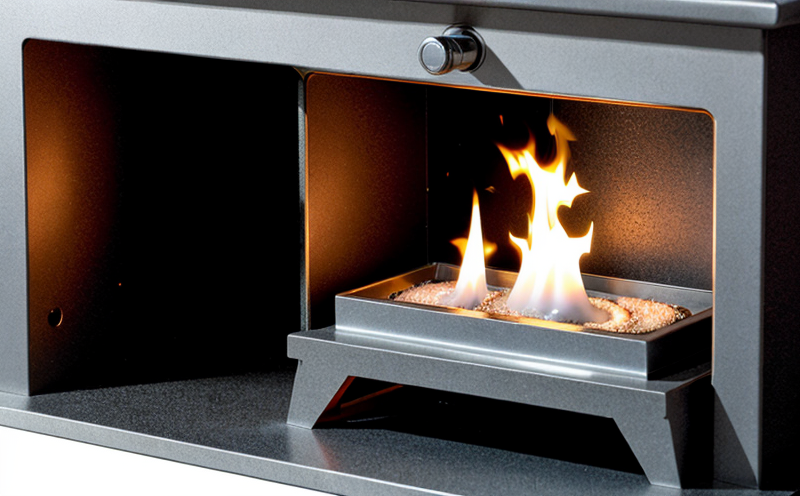Reaction-to-Fire Testing of Ceiling Panels
The Reaction-to-Fire testing of ceiling panels is a critical aspect of ensuring building safety and compliance with fire regulations. This test evaluates how quickly a ceiling panel ignites, the rate at which it spreads flame, and the extent to which it contributes to smoke production during a fire event. Such tests are essential for materials used in ceilings as they can significantly influence the spread of flames across the ceiling plane.
In the construction industry, ceilings play a vital role in providing acoustic insulation and thermal comfort while acting as a barrier that protects structural elements from fire damage. However, if not properly tested, ceiling panels could become potential fuel for fires, leading to rapid fire spread and increased smoke generation—both of which are detrimental to life safety.
Reaction-to-Fire testing is conducted in accordance with international standards such as ISO 13567-2:2014. This standard specifies the procedure for determining the flame propagation index (FPI) on flat ceilings using a large-scale test apparatus known as the Large-Scale Burning Test Apparatus (LSBA).
The LSBA is designed to simulate real-world fire conditions in a controlled laboratory environment. A ceiling panel specimen, typically cut from actual construction samples or prototypes, is placed horizontally within this apparatus. The specimen is exposed to a standard heat source, and the test measures how quickly flame spreads over its surface area.
This testing not only helps manufacturers understand their product's fire behavior but also assists designers in selecting appropriate ceiling materials that meet local codes and regulations. By performing Reaction-to-Fire tests early in the design process, stakeholders can make informed decisions about material selection and construction methods to ensure fire safety compliance without compromising on aesthetic or functional requirements.
For manufacturers of ceiling panels, this testing ensures they comply with national building codes such as NFPA 251: Standard Methods of Fire Tests of Building Construction and Materials. Similarly, for developers and architects specifying new projects, understanding the results from these tests allows them to specify materials that will perform reliably under fire conditions.
Furthermore, the findings from Reaction-to-Fire tests can be used in insurance policies to assess risk levels associated with different ceiling types. Insurers often require evidence of fire resistance certification prior to approving certain coverages for buildings equipped with less fire-resistant ceilings.
Scope and Methodology
| Parameter | Description |
|---|---|
| Test Specimen | Cut from actual construction samples, typically 1.5m x 1.5m (60 inches x 60 inches). |
| Heat Source | Flame impinging on the specimen for a duration of approximately 12 seconds. |
| Measurement Points | Multiple points along the length and width of the specimen to measure flame propagation rate. |
| Data Collection | Including time-to-ignition, flame spread index (FSI), and smoke production rate. |
The testing process begins with careful selection and preparation of the ceiling panel specimens. Specimens must be representative of the material composition intended for use in actual installations. Following proper cutting procedures to ensure uniformity across all samples, they are then mounted onto a specially designed test fixture inside the LSBA.
During the test, a standard heat source is applied to ignite one edge of the specimen. The rate at which flame spreads along the entire surface area is recorded using high-speed cameras and sensors placed strategically around the apparatus. Additionally, data on smoke generation is collected simultaneously to assess potential health risks associated with the material.
The results are analyzed based on parameters like Flame Spread Index (FSI), which ranges from 0 (non-flammable) to 45 (highly flammable). A lower FSI value indicates better fire performance, meaning slower flame spread and reduced smoke production. Compliance with specific limits defined by relevant standards ensures that the tested materials are suitable for use in various types of buildings.
Eurolab Advantages
At Eurolab, we offer comprehensive Reaction-to-Fire Testing services tailored specifically to ceiling panels. Our state-of-the-art facilities equipped with cutting-edge instrumentation provide accurate and reliable results that meet the highest industry standards.
- Expertise in Standards Compliance: Our team is well-versed in international fire safety regulations, including ISO 13567-2:2014. We ensure all tests conducted align with these guidelines to guarantee accurate interpretations of results.
- Comprehensive Reporting: Beyond basic flame spread and smoke production data, we provide detailed reports that include recommendations for improvement based on test outcomes. This helps our clients refine their products further if necessary before finalizing designs or launching new offerings into marketplaces globally.
- Fast Turnaround Times: Leveraging advanced technology and skilled personnel, Eurolab can turn around your Reaction-to-Fire tests swiftly without compromising quality. Timely delivery of reports allows you to act promptly on insights gained from the testing process.
By partnering with Eurolab for your Reaction-to-Fire Testing needs related to ceiling panels, you gain access to unparalleled expertise and resources aimed at enhancing fire safety within structures while adhering strictly to regulatory requirements.
Environmental and Sustainability Contributions
- Reduced Fire Risks: By identifying potential issues early through rigorous testing, we help reduce the likelihood of fire incidents. This contributes positively towards safer communities.
- Eco-Friendly Materials: Selecting materials that pass stringent Reaction-to-Fire tests ensures they contribute less to smoke and toxic fumes during fires—a significant step towards greener building practices.
Incorporating these considerations into the design phase helps promote sustainable development by minimizing environmental impact while enhancing occupant safety. At Eurolab, we strive not only for compliance but also for continuous improvement in our services to better serve society and planet alike.





